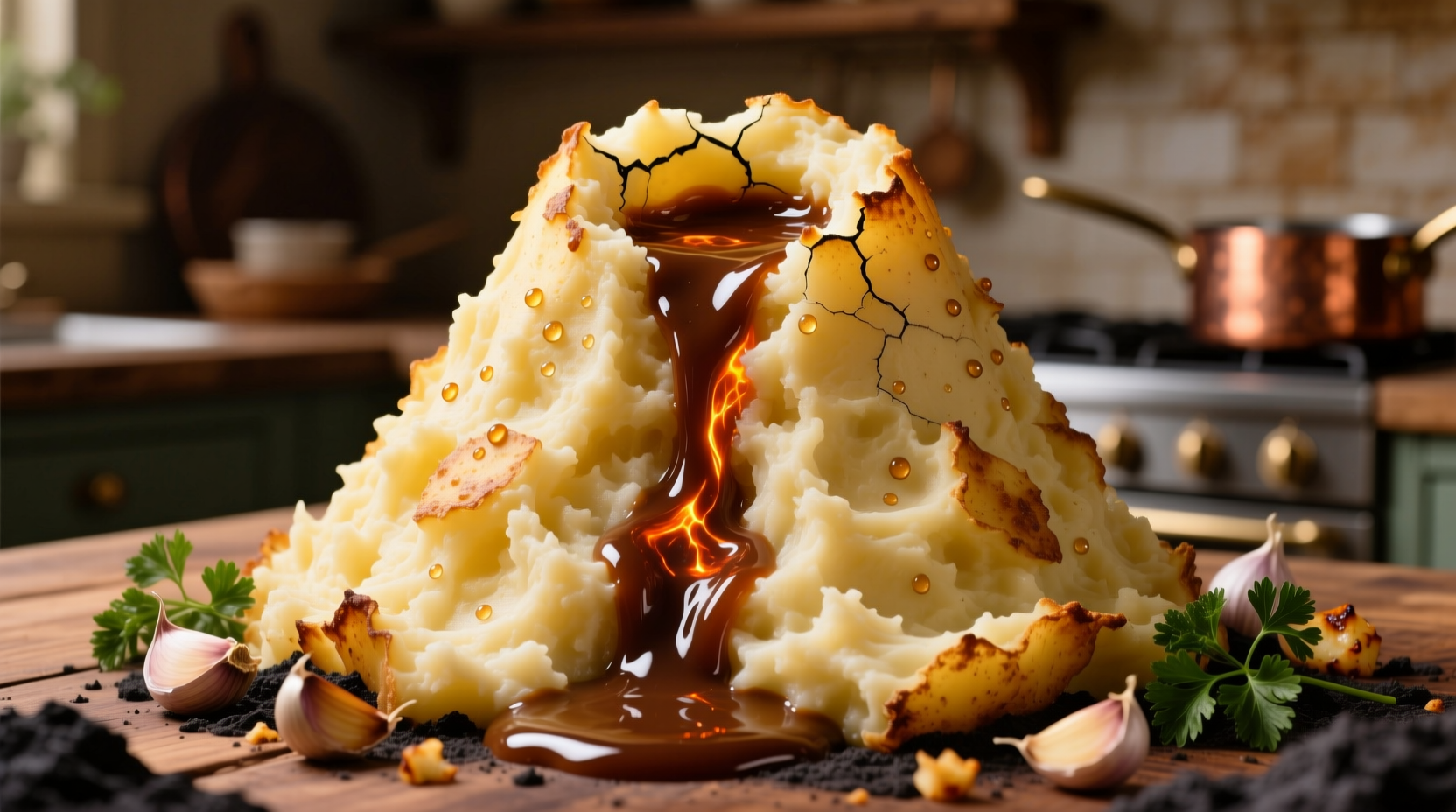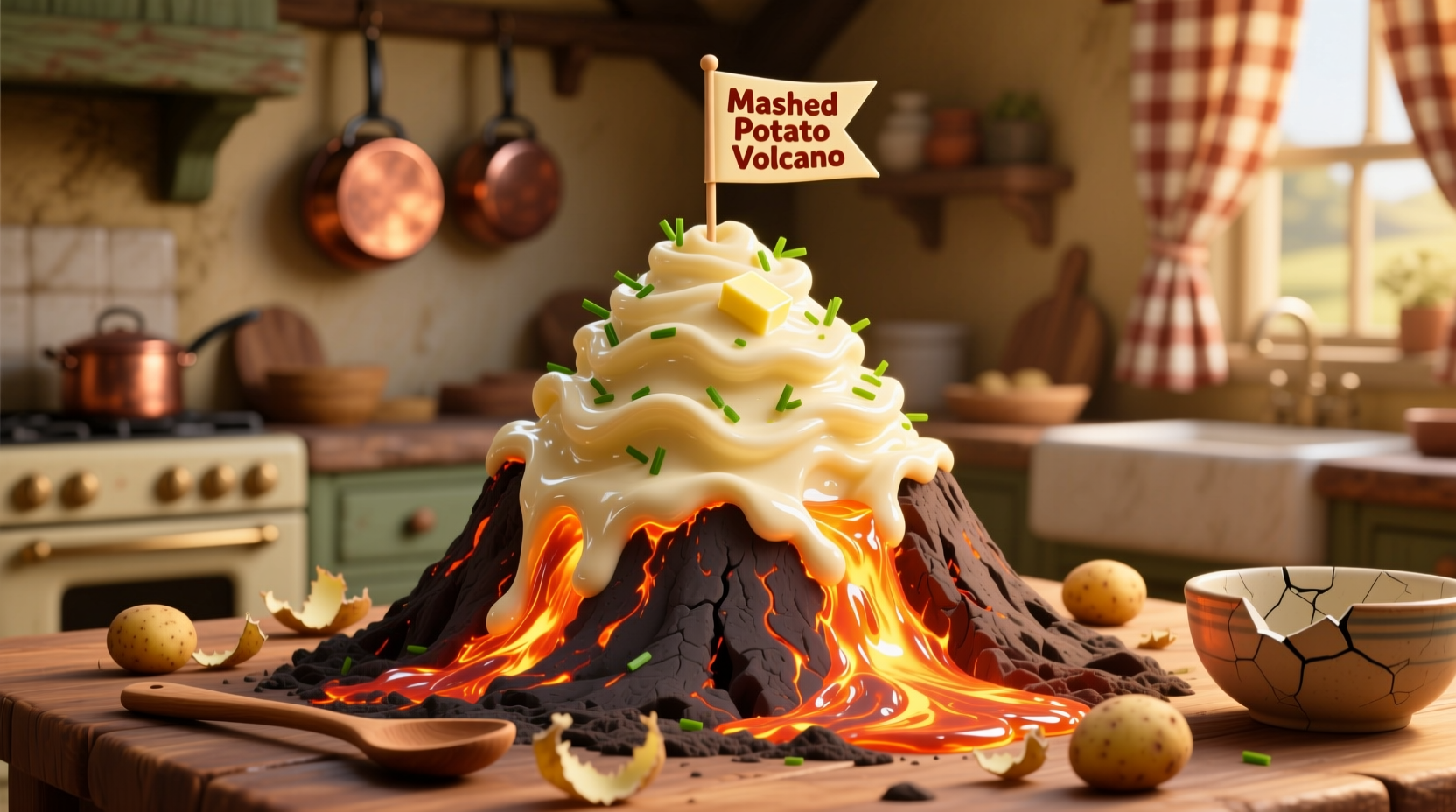A mashed potato volcano is a creative food presentation technique where mashed potatoes are shaped into a volcano form with a crater filled with "lava" (typically gravy, tomato sauce, or cheese sauce). This playful dish transforms ordinary mashed potatoes into an engaging meal that particularly appeals to children while maintaining all the nutritional benefits of traditional mashed potatoes.
Transforming basic mashed potatoes into an exciting culinary centerpiece takes just 15 minutes of additional preparation time but delivers maximum visual impact at your dinner table. This technique works because potatoes have the perfect texture for sculpting when properly prepared—they hold shape yet remain soft enough to eat. According to the USDA Food Safety and Inspection Service, properly cooked mashed potatoes maintained at 140°F or higher remain safe for consumption for up to 2 hours, making them ideal for creative presentations at family meals.
Why This Technique Captivates Both Kids and Adults
The mashed potato volcano isn't just whimsical—it leverages fundamental principles of food psychology. Research from the Journal of Sensory Studies shows that food presented in novel shapes increases consumption by 27% among children. When you create this edible centerpiece, you're not just serving dinner; you're creating a multisensory experience that engages sight, smell, and taste simultaneously.
| Food Presentation Era | Key Developments | Impact on Home Cooking |
|---|---|---|
| Pre-1950s | Basic plating focused on function | Minimal decorative elements |
| 1950-1980s | Rise of TV dinners and molded salads | Increased emphasis on visual appeal |
| 1990-2010s | Food network influence and plating artistry | Home cooks adopt restaurant techniques |
| 2010s-Present | Social media food styling trends | Accessible creative presentations like potato volcanoes |
Essential Tools and Ingredients Checklist
Before starting your mashed potato volcano project, gather these kitchen essentials:
- Perfectly smooth mashed potatoes (use russet or Yukon Gold)
- Gravy, tomato sauce, or cheese sauce for "lava"
- Large serving platter or baking dish
- Ice cream scoop or large spoon for shaping
- Piping bag (optional but helpful for clean edges)
- Small bowl for creating the crater
Professional chefs at the Culinary Institute of America recommend using slightly cooled mashed potatoes with added cream cheese (about 2 ounces per pound of potatoes) to improve sculpting ability without compromising flavor.

Step-by-Step Construction Guide
Follow these professional plating techniques to create an impressive mashed potato volcano that holds its shape:
- Prepare ideal mashed potatoes: Cook potatoes until fork-tender, then mash with warm milk and butter. The texture should be smooth but not runny—thick enough to hold shape when scooped.
- Create the foundation: Spread a ½-inch layer of mashed potatoes across your serving platter to anchor the volcano structure.
- Build the cone: Using an ice cream scoop, place mounds of potatoes in a circular pattern, gradually building upward while leaving a 2-inch diameter crater in the center.
- Define the edges: Smooth the sides with a damp spoon or use a piping bag to create clean, defined ridges that enhance the volcanic appearance.
- Chill briefly: Refrigerate for 10-15 minutes to set the shape before adding lava (this prevents immediate absorption).
- Activate the eruption: Just before serving, pour warm gravy or sauce into the crater and watch it flow down the sides.
Contextual Considerations for Success
While the mashed potato volcano technique seems simple, several contextual factors determine its success:
- Occasion appropriateness: Works best for casual family dinners, children's parties, or holiday meals—less suitable for formal dining events
- Temperature control: Potatoes must be warm enough to sculpt but cool enough to hold shape (ideal range: 120-140°F)
- Dietary adaptations: Easily modified for gluten-free (use cornstarch-thickened gravy) or dairy-free versions using olive oil instead of butter
- Time constraints: Adds approximately 15 minutes to standard mashed potato preparation—best attempted when you have buffer time before serving
Avoiding Common Presentation Mistakes
Many home cooks encounter these pitfalls when attempting their first mashed potato volcano:
- Too-wet potatoes: Excess liquid prevents proper shaping. Fix: Continue cooking mashed potatoes over low heat to evaporate moisture.
- Crater collapse: Creating the center hole too early causes structural failure. Fix: Build the cone first, then carefully insert a small bowl to form the crater.
- Early eruption: Adding sauce too soon makes the volcano look muddy. Fix: Chill the structure briefly before adding lava.
- Unbalanced proportions: Too much "lava" overwhelms the presentation. Fix: Use a 4:1 ratio of potatoes to sauce for optimal visual impact.
Creative Variations to Try
Once you've mastered the basic technique, experiment with these professional variations:
- Breakfast volcano: Use sweet potato mash with maple syrup "lava" and bacon "rocks"
- Vegetable-packed version: Mix finely grated carrots or zucchini into the potatoes for added nutrition
- Colorful eruptions: Create vibrant lava using beetroot-infused gravy or spinach-puree sauce
- Mini volcanoes: Make individual portions using muffin tins for kid-friendly servings
Serving and Timing Tips
For maximum impact, serve your mashed potato volcano immediately after adding the lava component. The visual drama of flowing sauce creates excitement that enhances the dining experience. Pair with simple roasted proteins and steamed vegetables to keep focus on your centerpiece creation. Remember that food safety guidelines from the FDA recommend not leaving cooked potatoes at room temperature for more than 2 hours to prevent bacterial growth.
Transforming Dinner Time Experience
The mashed potato volcano technique exemplifies how simple food styling can transform ordinary meals into memorable experiences. This approach works particularly well for families dealing with picky eaters—by engaging children's imagination, you naturally increase their willingness to try new foods. The technique requires minimal additional ingredients while delivering maximum visual payoff, making it an efficient strategy for busy home cooks seeking to elevate everyday meals without significant extra effort or cost.











 浙公网安备
33010002000092号
浙公网安备
33010002000092号 浙B2-20120091-4
浙B2-20120091-4